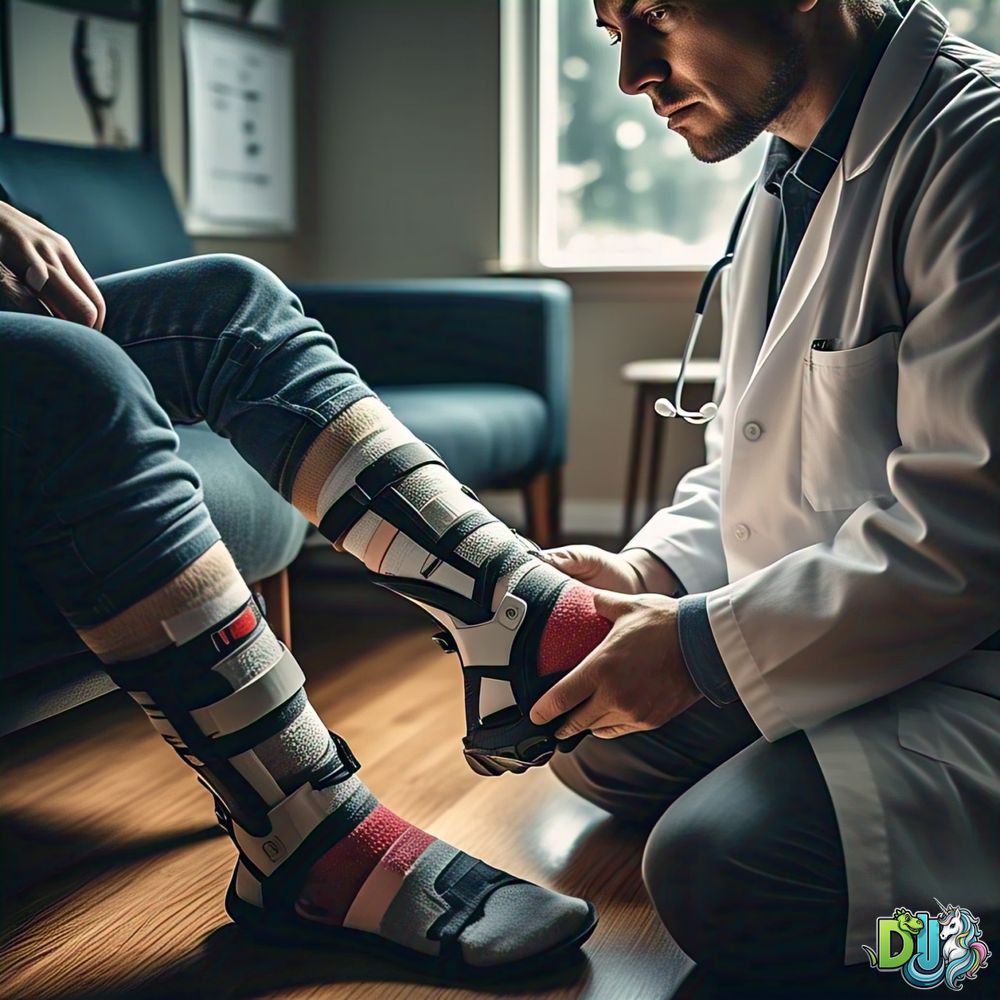Blog
How to Cure Plantar Fasciitis in One Week?
How to Cure Plantar Fasciitis in One Week
What is Plantar Fasciitis?
Understanding the Causes of Heel Pain
Plantar fasciitis is a common foot condition that causes intense heel pain due to inflammation of the plantar fascia, a thick band of tissue running along the bottom of your foot. This condition often develops from overuse, poor footwear, or sudden increases in activity levels.
Common Symptoms of Plantar Fasciitis
- Sharp pain near the heel, especially after waking up or standing for long periods
- Stiffness or soreness in the arch of the foot
- Discomfort that worsens with prolonged activity but improves with rest
Why Fast Recovery Matters for Plantar Fasciitis
Impact of Chronic Foot Pain on Daily Activities
Chronic heel pain can significantly hinder daily activities such as walking, running, or standing. Left untreated, plantar fasciitis may lead to compensatory injuries in the knees, hips, and lower back.
Benefits of Quick Treatment
Speedy recovery not only alleviates immediate pain but also prevents long-term complications and enables a return to normal activities within a week.

Effective Treatments for Plantar Fasciitis
Home Remedies to Relieve Plantar Fasciitis Pain
Rest and Foot Elevation Techniques
Resting the affected foot and elevating it can reduce swelling and inflammation. Avoid high-impact activities like running or jumping until symptoms improve.
Best Foot Massage Methods for Pain Relief
Using a tennis ball or a frozen water bottle, roll your foot over the object for 5-10 minutes to loosen tight tissues and reduce inflammation. Regular massages stimulate blood flow and help relax tight muscles and tissues.
Heat Therapy for Pain Management
Applying heat packs can promote blood flow and soothe muscle tension. Use heat therapy in combination with gentle stretching exercises for the best results.
Best Exercises and Stretches for Fast Recovery
Calf and Heel Stretch Techniques
- Wall Stretch: Stand facing a wall, place your hands on the wall, and step one foot back. Keep the back leg straight with the heel on the ground. Hold for 30 seconds and switch sides.
- Towel Stretch: Sit with your legs extended. Loop a towel around the ball of your foot and gently pull the toes toward you. Hold this position for 20-30 seconds.
Strengthening Exercises for Foot Muscles
- Toe Curls: Place a towel on the floor and use your toes to scrunch it toward you. Repeat 10 times per foot. Strengthening the toe muscles can reduce the strain on the plantar fascia.
- Marble Pickups: Place several marbles on the floor and use your toes to pick them up one by one. This exercise improves the flexibility and strength of foot muscles.
- Ankle Rotations: Sit with one leg extended and slowly rotate your ankle in circles for 30 seconds in each direction.
Step-by-Step Guide to Morning Stretch Routines
Start your day with gentle stretches before getting out of bed to reduce morning pain:
- Pull your toes toward your shin for 30 seconds.
- Perform 10 ankle circles in each direction.
- Massage the arch of your foot with your hands.
- Follow with standing calf stretches to further loosen tight muscles.
Natural Ways to Heal Plantar Fasciitis
Using Ice Therapy Effectively
Apply ice packs to the affected heel for 15-20 minutes, 3-4 times a day to reduce swelling and numb pain. Frozen water bottles work well for this method.
Essential Oils and Natural Pain Relief Options
Essential oils like peppermint, eucalyptus, and lavender may provide anti-inflammatory benefits. Mix a few drops with a carrier oil and massage onto the affected area.
Epsom Salt Soaks
Soaking your feet in warm water with Epsom salts can relax foot muscles and reduce inflammation. Soak your feet for 15-20 minutes once or twice a day.
Products and Tools to Speed Up Healing
Best Insoles for Plantar Fasciitis Recovery
Orthotic insoles provide arch support and cushioning, reducing strain on the plantar fascia. Look for products with firm arch support and shock absorption.
Compression Socks: Do They Work?
Compression socks improve blood circulation and reduce swelling, promoting faster recovery from plantar fasciitis. They are particularly useful for individuals who must stand or walk for long periods.
Night Splints for Pain Relief
Night splints hold the foot in a dorsiflexed position, keeping the plantar fascia stretched overnight. This can reduce morning pain and stiffness.
Massage Tools
Foot rollers, massage balls, and electric massagers can provide targeted relief for plantar fasciitis pain.

Long-Term Solutions and Prevention Tips
Lifestyle Changes to Prevent Recurrence
Proper Footwear Recommendations
- Choose shoes with good arch support and cushioned soles.
- Avoid flat sandals, high heels, and worn-out shoes.
- Consider custom orthotics for additional support.
Maintaining a Healthy Weight
Excess weight places additional stress on the plantar fascia. Maintain a balanced diet and engage in low-impact exercises like swimming or cycling to stay fit.
Incorporating Regular Foot Exercises
Performing foot stretches and strengthening exercises regularly can help maintain flexibility and prevent future injuries.
When to Consult a Specialist
Signs You Need Professional Treatment
- Persistent pain despite home remedies
- Swelling or bruising around the heel
- Difficulty walking or bearing weight
- Pain that worsens over time instead of improving
What to Expect from Physical Therapy
Physical therapists can design personalized exercise programs, provide hands-on treatments, and recommend specialized equipment for recovery. Therapy sessions may include ultrasound therapy, manual massage, and gait analysis.
Medical Interventions
- Corticosteroid Injections: Reduce inflammation for severe cases.
- Extracorporeal Shock Wave Therapy (ESWT): Stimulates healing in chronic cases.
- Surgery: Rarely required but may be an option for persistent cases.

FAQs about Curing Plantar Fasciitis in One Week
Q1: Is it possible to completely cure plantar fasciitis in one week?
A1: While complete recovery may vary, significant pain relief and improvement can be achieved within a week with proper care, stretches, and treatments.
Q2: What are the most effective stretches for plantar fasciitis?
A2: Wall stretches, towel stretches, and toe curls are highly effective for relieving plantar fasciitis pain.
Q3: Can I continue exercising with plantar fasciitis?
A3: High-impact activities should be avoided, but low-impact exercises like swimming and yoga may be beneficial.
Q4: How do I choose the best insoles for plantar fasciitis?
A4: Look for insoles with firm arch support, cushioned heels, and good shock absorption.
Q5: When should I see a doctor for plantar fasciitis?
A5: Consult a healthcare professional if pain persists for more than two weeks despite self-care treatments.
Q6: Are night splints effective for plantar fasciitis?
A6: Yes, night splints keep the plantar fascia stretched overnight, reducing morning pain and stiffness.
Q7: Can weight loss help with plantar fasciitis?
A7: Yes, maintaining a healthy weight reduces pressure on the plantar fascia and helps prevent recurrence.
Q8: Is ice or heat better for plantar fasciitis?
A8: Ice is better for reducing inflammation, while heat can relax tight muscles. Both can be used alternately for best results.
By following this comprehensive guide, users can effectively manage and potentially cure plantar fasciitis within a week, regaining comfort and mobility in their daily lives.
Please visit Dinounicorn.com or Freshmilktee.com to support us. Thank you!
 Skip to content
Skip to content

